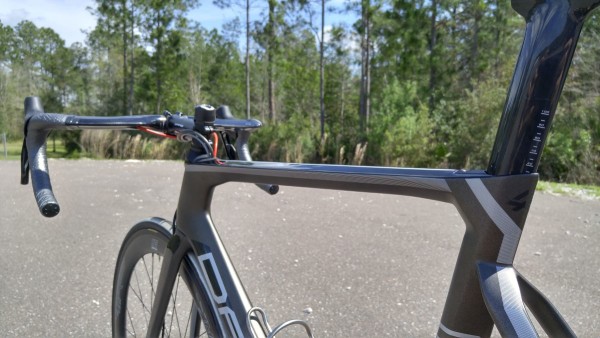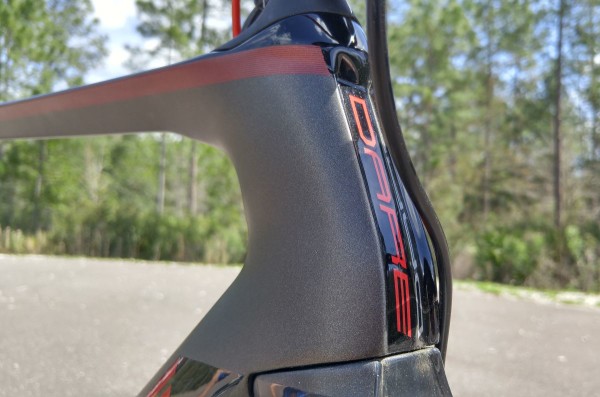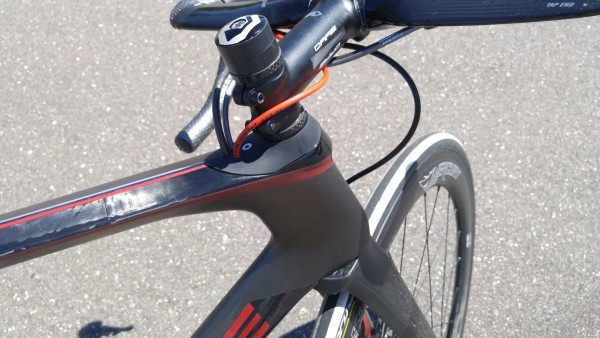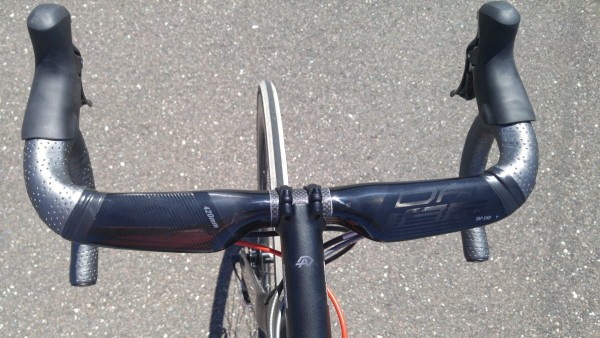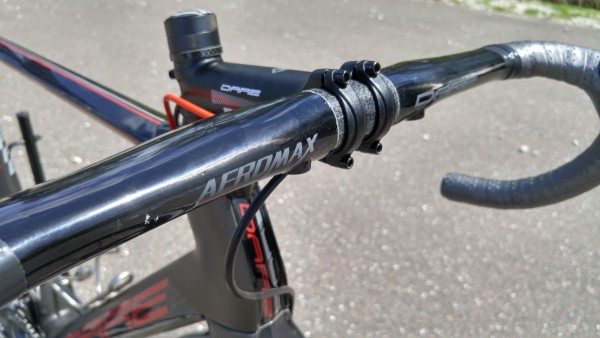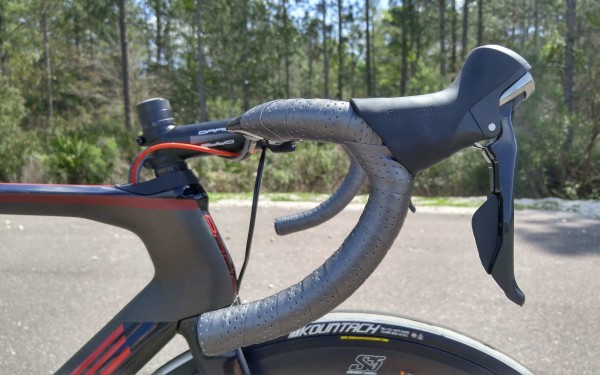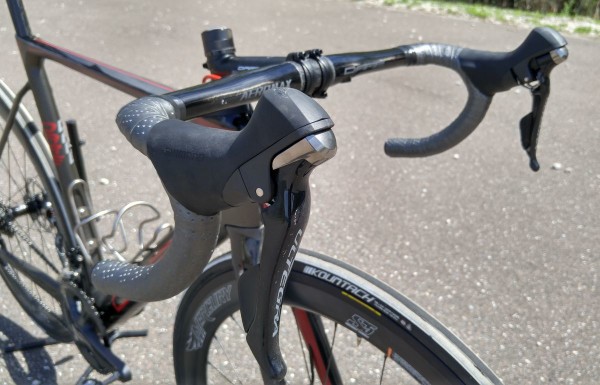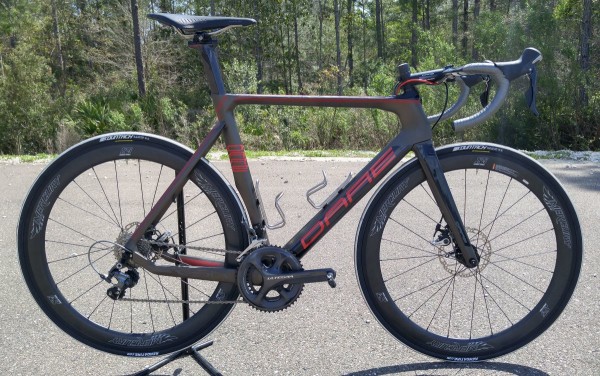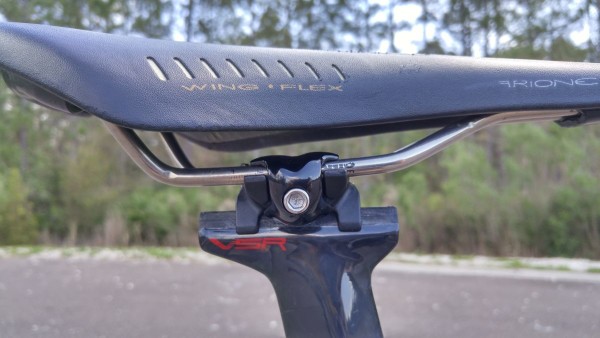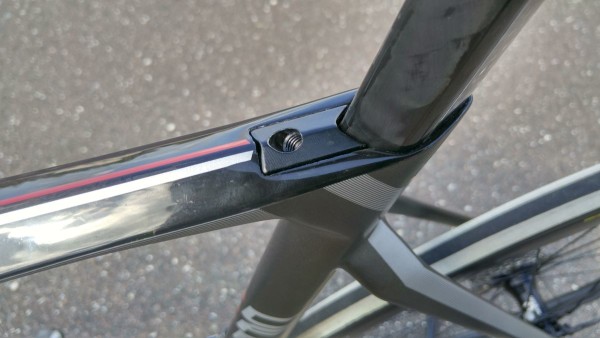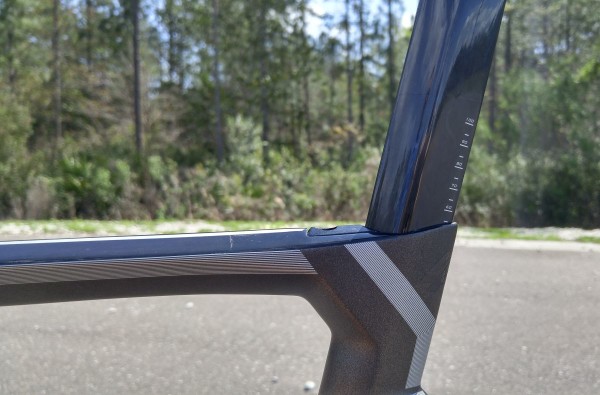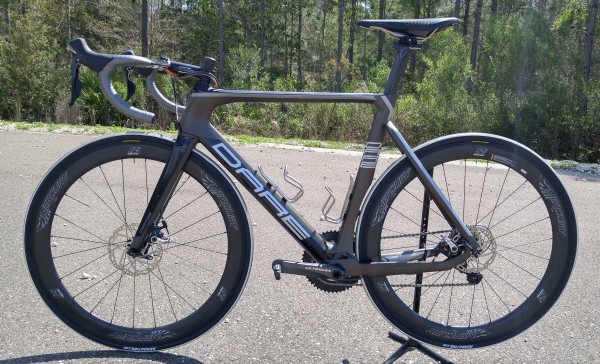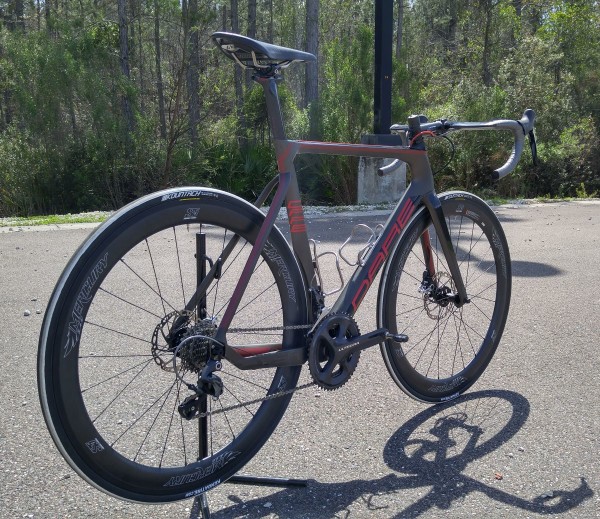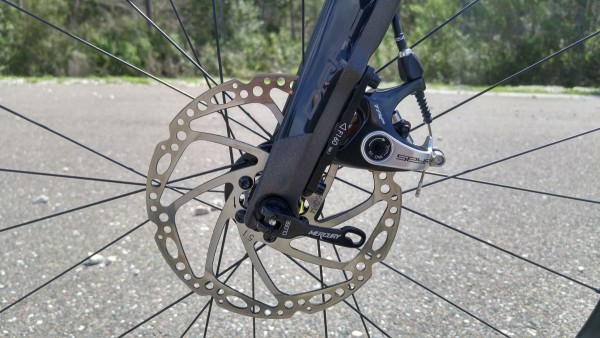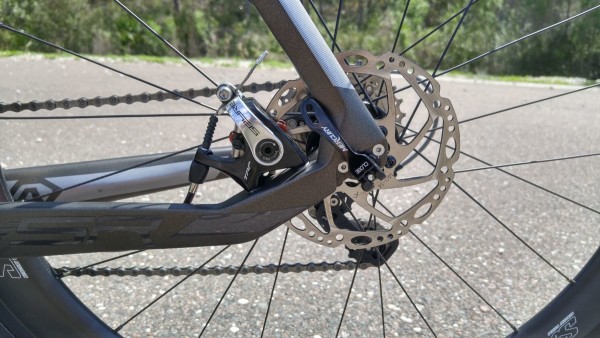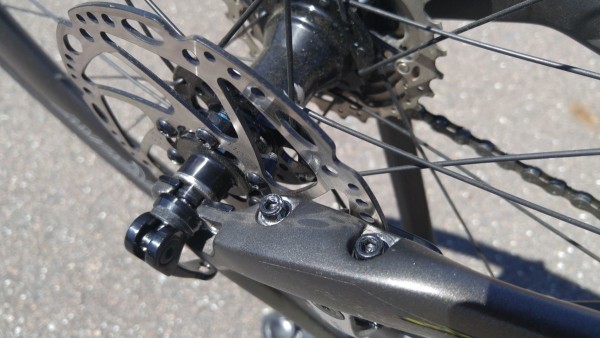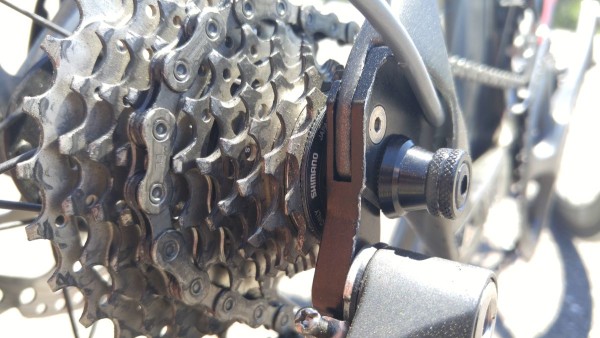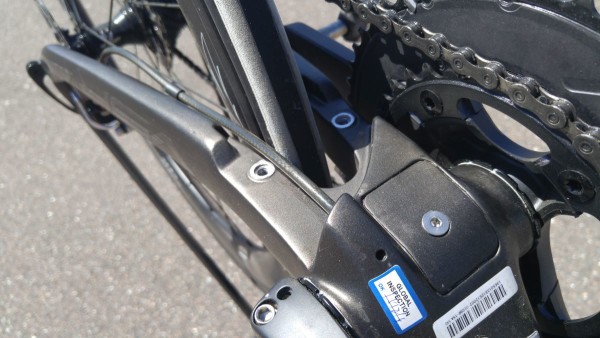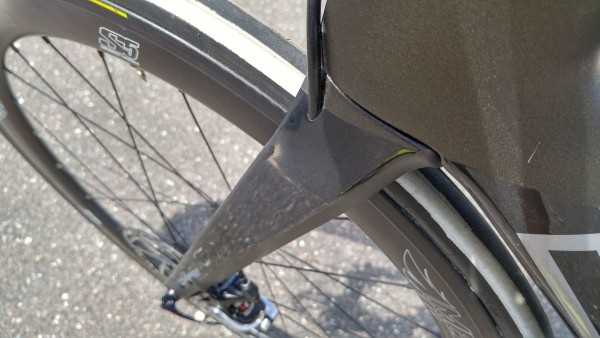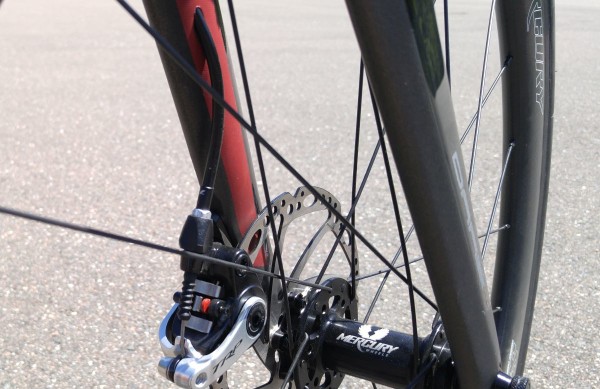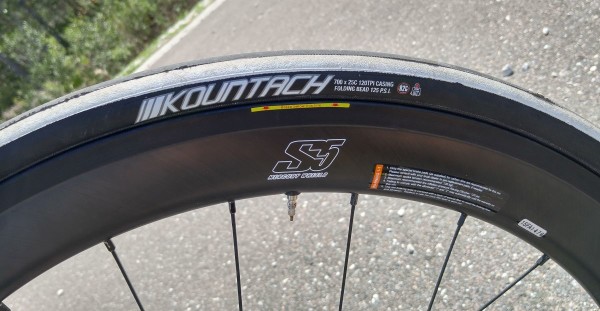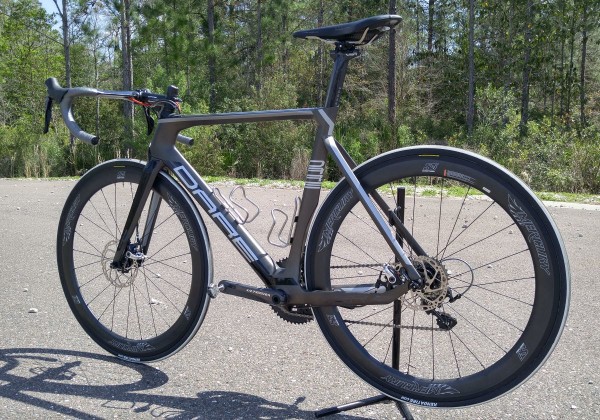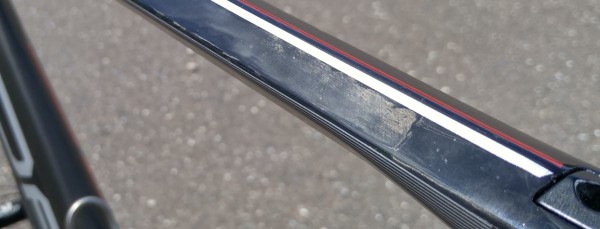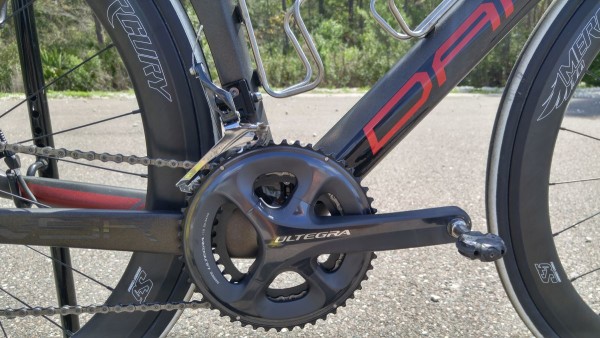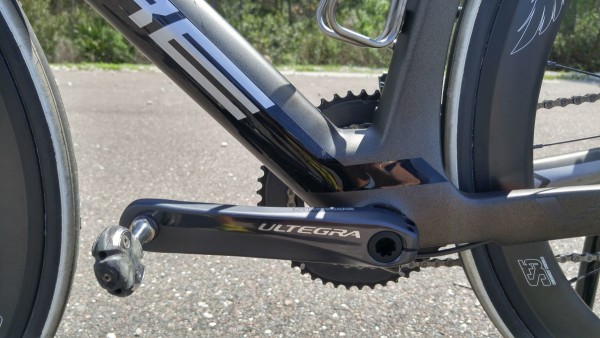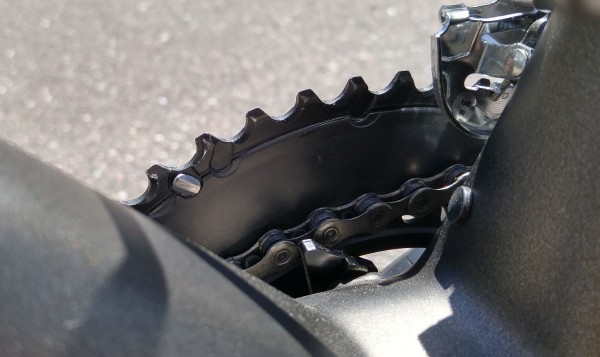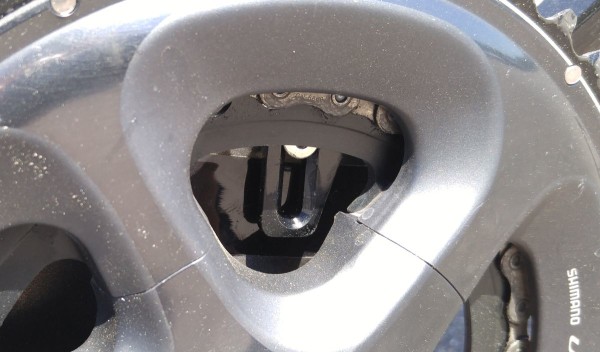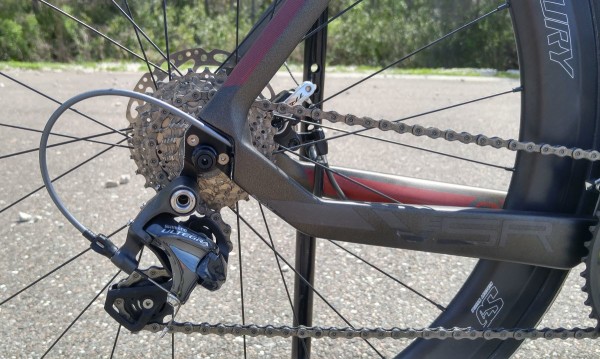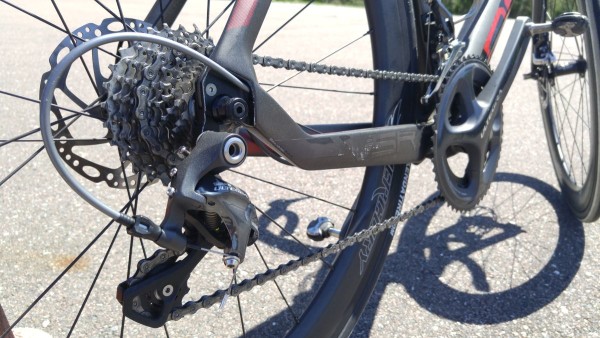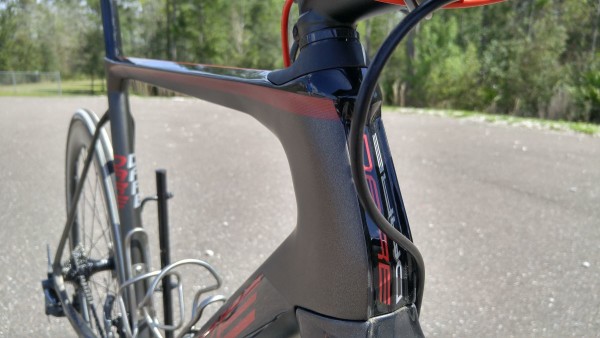“We know how to develop a bike that is close to perfection” says Dare Bikes. That’s a bold claim to make, but they’ve garnered much experience from OEM manufacturing, quietly producing bikes for manufacturers such as Norco and Lapierre. Dare Bikes founded their own brand and line of bikes in 2011, and is preparing to enter into the market with machines such as the VSR – “Vetox Speed Race” – an aerodynamic road bike introduced earlier this year that can be fitted with disc brakes or rim brakes.
The VSR features Dare’s Vetox design concept, “like a blade that breaks through air resistance”. It starts with an uniquely shaped head tube featuring a groove design that splits and routes airflow cleanly around the front of the bike. Paired with the profile of Dare’s disc brake fork, the company claims a 30% reduction in turbulent airflow around this area of the bike. The BikeRumor wind tunnel was fully booked, preventing us from testing these claims, but that didn’t stop us from racking up some quality miles on the VSR and its disc brakes. Click on through to read Part One of our review…
The lines of the VSR’s head tube are visually striking, but disturbed by the presence of the front brake cable. I’m no aerodynamic expert, but I’m wondering if claims of aerodynamic efficiency around the front of the bike are compromised by that cable. However, routing cables cleanly can be a tricky affair, and resorting to a wind-cheating design typically results in a mushy feel at the brake lever. On the VSR, feel at the brake lever is great, but more on that later.
The head tube is capped by an aerodynamic upper cover and circular cone. This allows for unrestricted steering with absolutely no binding. This being a test bike that we need to return, we left the steerer tube uncut.
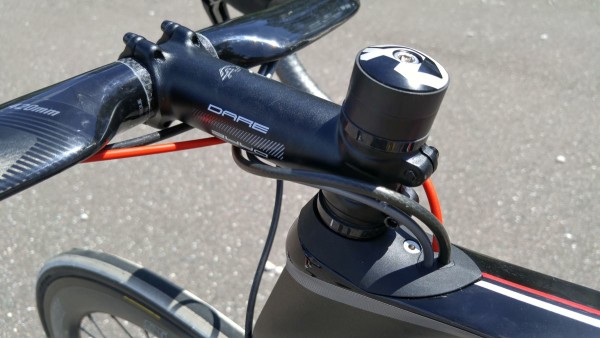
Shifter cables and rear brake cable, whether electronic or mechanical, are routed inside the frame and enter behind the stem.
The handlebar on the VSR is a Dare branded Aeromax unit and features a flattened, teardrop like section, perfect for perching one’s hands for riding the bar tops.
No complex and proprietary stems are used on the VSR; the 120mm stem that came with the bike provided the perfect fit.
Handlebars and saddles are a personal choice, but the Dare Aeromax handlebar suited me well. All cables are routed inside the handlebars.
The Dare VSR is available in six sizes, beginning at XSmall with a 51cm top tube, ending at XL with a 59cm top tube. If you’ve read any of my bike reviews, you’ll know I have a preference for a more aggressive fit. Typically I choose the smallest bike I can get away with, and use a setback seatpost and longer stem to attain my ideal position.
Oddly, the size M/L bike I chose has a seat tube measurement of 54cm center to center and top tube of 53.9cm center to center. Dependent on frame manufacturers, I usually select a size small or medium frame, but numbers are always the most accurate guideline. Thankfully, the Dare VSR includes an excellent gloss-coated carbon seatpost that features a simple single bolt clamp, allowing me to slide my saddle into the perfect position. The seatpost has plenty of fore and aft adjustment, providing a relative angles from 73 to 77 degrees.
The integrated and hidden seatclamp with fixing bolt sized for a 4mm allen key is a simple wedge design that drops into place to securely hold the seat post. However, the seat post slipped during my first ride on the Dare VSR. I attributed the slippage to the post’s glossy clear coat, and an application of carbon paste solved this problem.
The seat post includes handy measurement markings, beneficial for tweaking one’s ideal saddle height. For those running a Shimano Di2 electronic drivetrain, the system’s battery is contained within the seatpost’s integrated holder.
The Dare VSR looks fast no matter the viewing angle.
Dare warns the VSR will turn heads and garner the attention of other cyclists. This is fact. I’ve appeared on a few group rides aboard the VSR and it always draws attention – and questions – particularly about how it rides and how about those disc brakes?
No matter your opinion of disc brakes on road bikes, they are here and more are coming. Their braking power in all weather conditions is undeniable, a boon for when conditions turn nasty. The Dare review bike came fitted with TRP’s Spyre flat mount mechanical brakes front and rear, slowing the bike on 160mm / 140mm rotors.
While I prefer the increased power of TRP’s HY/RD hybrid mechanical / hydraulic brake calipers, the Spyres nevertheless offer excellent brake power once the initial bedding in of the pads has taken place. A little at odds with the bike’s cutting edge design, Dare eschew the thru-axle interface for regular quick releases. However, this has more to do with the dual-purpose nature of the VSR. Thru-axles are generally associated with disc brakes and not rim brakes, and this bike can be fitted with either type.
The flat mount rear disc brake attaches from below the right chainstay, with the brake housing running externally and parallel to the inside of the chainstay.
To cater to both braking standards – 135mm disc brake hub – or road rim brakes with a 130mm hub, the VSR features ISIS – International Standard Integrated System – not to be confused with ISIS bottom brackets, Archer, or… simply put, the bike’s dropouts can be swapped to cater to either axle width. In the event of a crash, the sandwich design of the dropout is designed to breakaway at its attachment points. Ideally, the dropout will deform and break without damaging the carbon fiber. The dropout is stiff with no compromises in shifting performance.
Beneath the bottom bracket shell is the access port for routing of mechanical or electronic shifter cables. Also visible in the above photo are the mounting points for the rim brakes when the bike is so equipped, and the rear disc brake cable housing.
Despite the front brake cable interrupting the otherwise clean front end, the routing makes for excellent brake feel at the lever. Braking power is strong and modulates well, doing exceptionally well in wet conditions.
While I didn’t have the chance to bomb any lengthy descents in the rain, the brakes quickly slowed the bike as the rain poured down. If you’ve ridden disc brakes on an MTB, you’re aware of the pinging and tinging sounds that emanate from the rotors as dirt and crud particles briefly touch on the pads. On a road bike, these noises are exacerbated and may drive some cyclists a little insane…
Mercury’s S5 clincher disc brake wheelset featured on the review bike. Built with Sapim’s Race model spokes, the wheels feature 20 spokes front and 24 rear. The wheelset isn’t light, but once up to speed, it stays there. The wheels are stiff but reverberate plenty of road noise as you roll along the road.
I tip the scales at around 155lbs and was blown around during strong side winds, particularly at the front wheel. I’d prefer a shallower wheelset, but bigger and more powerful riders will love the Mercury S5’s. On a slight negative, the rear hub of the Mercury wheelset arrived out of adjustment, over tightened, squealing and carrying on during the most inopportune of times – while rotating through a paceline. I’m sure the other cyclists in attendance weren’t impressed with the noises emanating from such a pricey bike. On the positive, the rear hub was easy to adjust and the problem was solved. The wheels were shod with the Kenda Kountach 700c x 25mm clincher tire.
The carbon fiber in the Dare VSR frame was developed in cooperation with Toray and utilizes a multi-ply, synthetic and hot-melted carbon fiber resin – aka HS-HMC prepreg. This new kind of prepreg carbon fiber has an extremely low FAW (Fiber Areal Weight), reducing the weight of traditional sheet by 10 grams. And that savings is despite the fact Dare’s carbon sheets comprise of nine layers of carbon fiber, versus four in most traditional sheets.
T1000, M40 and M46 carbon fibers are laminated over different sections of the frame. Varying tube shapes, angles and contours abound on the Dare VSR.
As expected, the Shimano Ultegra 11-speed mechanical drivetrain installed on the review bike performed flawlessly. The crankset turns on the VSR’s 86.5mm pressfit bottom bracket.
The “APT” -Dare’s Asymmetric Enhanced Power Transfer Zone- aka “beefy bottom bracket” as I prefer to call it, utilizes an asymmetric design to deal with the output of higher pedaling forces that generally come from the drivetrain side of the bike. The left side chainstay is enlarged to negate deformation from the right side, outputting all of the rider’s power into the drivetrain.
The bottom bracket area includes a nifty, integrated chain catcher that can be adjusted for various chainring sizes. Incidentally, the bottom bracket refused to budge during my out of the saddle efforts. Likewise, the chain refused to rub against the chain catcher during small ring, out of the saddle efforts on steep grades.
The rear derailleur cable is hidden from view until it exits at the dropout. Shifting is noisy at times; gear shifts on this bike emanate in a resounding clunk, a side effect of the frame and deep section wheels.
Pictured with my personal King titanium cages, Speedplay Zero Titanium pedals and Fizik Arione saddle, the Dare VSR weighs bang on 18lbs. Not an overly light bike by today’s standards, but on par with other aero bikes on the market.
Despite a couple of minor issues mentioned earlier in the review, the VSR is a pleasure to ride. I feel the VSR is best suited to a powerful rider, particularly a sprinter, who can take advantage of the frame’s stiff but forgiving ride. If you desire speed, this is a bike worthy of consideration. Placebo effect or otherwise, the VSR feels fast and looks fast. The Mercury wheels certainly help – it flies!
Does the VSR need disc brakes? That’s a personal choice but they are a natural fit for the high-tech nature of the frame. I certainly enjoyed the benefits of their added performance. For Part Two of this review, I will be switching the VSR to rim brakes. That involves a fork, wheels, dropout and brake swap. Those details including the changeover process will be shared in the next installment.
At this time, the Dare VSR is only available to the Asian market or to teams sponsored by the company, but their plan is to bring start selling into North America. Price and timeline are to be determined, but when available, the VSR will sold as a module comprising frame, fork, headset, seatpost and handlebar.
Photos and article by Gravel Cyclist. Jayson O’Mahoney is the Gravel Cyclist: A website about the Gravel Cycling Experience.

